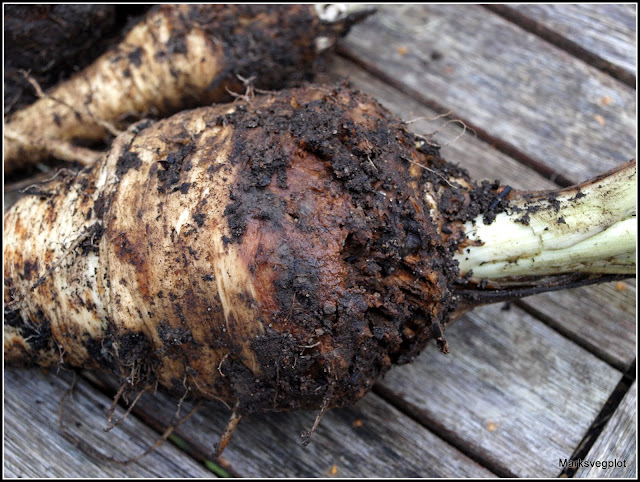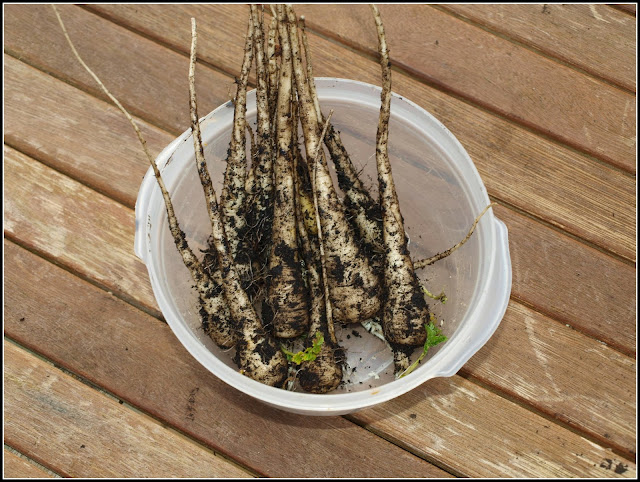I'm in the former category. I have some reservations though: Parsnips "boiled to death" are horrible, and I can see why someone would say they didn't like Parsnips if that was the only way they had ever tried them. By contrast, Parsnips roasted in some lard until they are golden are amazingly good, and cooked as chips in our Actifry machine they are as the saying goes "To die for"!
 |
| Parsnip chips cooking in the Actifry |
Of course they are even better if you grow them yourself, and cook them soon after harvesting.
In my experience though, growing Parsnips is not as easy as it might be, and certainly not always successful. Over the years I have grown some shockingly-bad Parsnips... Sometimes they are "forked" like this one:
Sometimes they suffer from the dreaded canker disease:
Sometimes they are just too darned small:
On the other hand, I have also managed to grow a fair few competent specimens:
So what is it that makes the difference between success and failure with Parsnips? Here are some tips that might help.
The first thing to note is that Parsnip seed is notoriously short-lived. Two-year-old seed will probably be OK, though at a reduced germination-rate, but if you want to maximise your chances of success, buy new seed every year.
Parsnip seed also takes a fair while to germinate (a month is not unusual), and it's pointless sowing it too early in the year, before the soil has warmed up. They need a temperature of about 12C / 52F to germinate. I live in Hampshire, in the South of the UK, and I normally sow mine under cloches in late March, but to be honest late April or early May would probably be better.
Parsnips don't seem to be fussy about soil conditions, and many people grow them very successfully on some pretty rough ground, but I grow mine in raised beds which have been intensively cultivated for years and in which the soil is very light and stone-free. Parsnips are quite prone to forking (i.e. developing multiple roots instead of just one), so anything you can do to reduce this will be welcome - for instance removing stones and adding sand to the soil, but not manuring it. Too much nitrogen (e.g. from fresh manure) prompts the plants to produce a lot of soft leaf and not so much root.
Parsnips are not generally well-suited for growing in containers, but if you want to have a try, I suggest you choose a short-rooted variety, such as "Guernsey Half-Long" or "White Gem". Many of the larger varieties produce roots that go down at least two feet, sometimes more.
Spacing is also fairly important. If your Parsnips are too crowded the roots will inevitably be small. Of course, that may be what you want, but most people prefer a smaller number of bigger roots, so I propose a spacing of no less than 6" / 15cm between plants. I have found that Parsnips don't like being transplanted, so it is better to sow directly into their final position, or into modules that can be planted-out without root-disturbance. A Parsnip seedling transplanted "bare-root" style seldom develops to a useable size, so it is a waste of time trying to fill any gaps in your rows. It's better to sow thickly and thin-out once you see how many germinate.
Once your plants have been thinned-out to your satisfaction, there is little else to do, except watch them grow. If the weather is very hot and dry, some watering may be necessary, but since Parsnips have such long roots they can reach a long way underground in their search for moisture. If you do end up watering, remember that an occasional good soaking is better than more frequent light sprinkling.
Your Parsnip plants will probably develop some pretty big leaves, but don't let that deceive you into thinking they are ready for harvesting. Parsnips are naturally biennial, which means they put on most of their growth in their first year, and store their energy in a swollen root which is used to produce a flower in the second year. We short-circuit their system by "stealing" the roots before they have a chance to flower. When the roots are ready for harvesting the leaves will have died down more-or-less completely. This is likely to be in late Autumn or early Winter. Tradition dictates that we should not harvest before the first frosts, since frosting helps to convert starch to sugar and makes for sweeter Parsnips. Over-Wintered Parsnips will begin to re-sprout in the early Spring and you need to use them ASAP if you see that happening.
 |
| Parsnips growing in a raised bed, protected by Enviromesh |
Parsnips lend themselves to being picked on an "as required" basis, and unless you really need the space, it is best to leave them in the ground until you want to eat them, rather than lifting them all at once. Since the foliage dies down so completely, it might be a good idea to mark their location with a few sticks, especially if snow is expected.
Most of the Parsnip varieties I have grown claim to be "canker-free" or almost so, but I have not found that to be the case. Almost every year my Parsnips get canker to a certain degree. Usually this fungal disease is not too severe and causes only mild disfigurement. Unless you are growing the vegetables for showing, I think it is not something to worry about. If I knew what causes it, I'd tell you how to avoid it! The unsightly brown lesions are usually only skin-deep and are removed when peeling the vegetables for eating.
 |
| This level of canker-infestation is not unusual |
Finally, a word about choice of varieties. There are plenty to choose from these days, and in the seed catalogues they all seem to be described as "the best ever". My own personal preference is for the old-fashioned ones (i.e. the ones that have stood the test of time!) like "Gladiator", "Hollow Crown" and "Tender and True". This is because although they may perhaps not be as sleek, white and good-looking as the modern F1 varieties, they generally have better taste - and after all, that's what most of us want from home-grown veg!
There's one other factor that I want to mention, which has a big influence on the quality of my Parsnips - Luck! (Actually, it's more likely the weather). I use more-or-less exactly the same methods each year, and sometimes I get poor Parsnips and sometimes I get great ones. I therefore wish you loads of luck with your Parsnip-growing ventures...








Great post Mark, sound advice. I was told I'd struggle to grow parsnips but they seem easier than some people fear. I've had some good harvests, but they are definitely a mixed bag, I've had a few perfect specimens and some really bizarre shapes too, as well as a full range of sizes. But as you say it's all about taste!
ReplyDeleteMakes you wonder what proportion of the commercially-grown ones get thrown away, doesn't it? Wonky Veg only goes so far...
DeleteI don’t think any veg benefits from overcoming. We have been pleased with this year’s parsnips but as you say digging them is a bit like buying a raffle ticket as you never know what you will get. It always seems to produce a mixed bag.
ReplyDeleteWe grow parsnips every year - with the mixed results you describe so well. You can always fall back on Tender and True. The core can be larger and hard but unbeatable for flavour!
ReplyDelete